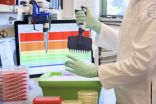(Press-News.org) The secret to preventing HIV infection lies within the human immune system, but the more-than-25-year search has so far failed to yield a vaccine capable of training the body to neutralize the ever-changing virus. New research from The Rockefeller University, and collaborating institutions, suggests no single shot will ever do the trick. Instead, the scientists find, a sequence of immunizations might be the most promising route to an HIV vaccine.
Scientists have thought for some time that multiple immunizations, each tailored to specific stages of the immune response, could be used to generate a special class of HIV-fighting antibodies, so-called broadly neutralizing antibodies. The findings, published June 18 in Cell and the result of a collaborative effort by Rockefeller, The Scripps Research Institute, Weill Cornell Medical College, and other institutions, provide the first evidence supporting this approach.
"As HIV mutates in a patient, the immune system continually adapts. In some patients, this process produces broadly neutralizing antibodies, which are unusual antibodies that can bind to and neutralize a wide range of globally occurring HIV variants. These are the antibodies we want to try to elicit with a vaccine," says co-first author Pia Dosenovic, a postdoctoral fellow in Michel Nussenzweig's Laboratory of Molecular Immunology at Rockefeller.
"Our experiments suggest that by stimulating the immune response with tailored immunizations at specific stages, it may be possible to successfully mimic this process," says co-first author Lotta von Boehmer, an instructor in clinical investigation also in Nussenzweig's lab.
HIV is a pernicious virus precisely because its continual mutations make it a difficult target for antibodies, immune proteins that recognize foreign molecules called antigens. But one part of the virus cannot mutate: the binding site on the spike protein with which the virus attacks immune cells known as CD4 T cells. This part of the virus can't change because without it, HIV would not be able to attach to and infect the T cells. As a result, it is a key part of the antigen targeted by some broadly neutralizing antibodies, which overcome attempts by the virus to protect this vulnerable site.
A small number of HIV patients develop broadly neutralizing antibodies naturally, as a result of infection. Like all other antibodies, they are produced by a type of immune cell, known as a B cell, which undergoes rounds of mutations that refine its antibodies' ability to precisely target a specific antigen. As compared with antibodies against other pathogens, such as flu, these broadly neutralizing antibodies are distinctive, in part because they have undergone a great deal of mutation. Researchers have been working to find a shortcut to the process, but so far these broadly neutralizing antibodies have proven difficult to elicit with a vaccine.
But where one vaccine has failed, perhaps two or more can succeed. The Rockefeller research team tested how two variations of the crucial HIV antigen affected the B cells' response when administered either early in the progression of the immune system's initial response to HIV, or later during the process. The work was conducted in mice genetically engineered to produce antibodies resembling those of humans.
One group of mice had antibodies with no HIV-targeting mutations; these represented a B cell response during the early stages of infection. The antibodies expressed by the other mice contained mutations associated with the development of broadly neutralizing antibodies, and so stood in for a later stage of infection.
For each scenario, they tested both types of antigens. The first, an antigen engineered to make the crucial CD4 binding site easily accessible, was made by William Schief and colleagues at Scripps. The second, designed by John Moore and Rogier Sanders at Weill Cornell, closely resembled the natural version found in HIV.
For the early-stage scenario, the engineered antigen showed promise by prompting the antibody-producing B cells to proliferate and produce antibodies with key traits representing a preliminary step toward the production of broadly neutralizing antibodies. Meanwhile, the more natural antigen was more effective later on, inciting the mice to produce antibodies capable of neutralizing a number of different HIV strains.
"The engineered antigen made it possible for the mice's hybrid immune system to get the response started. However, the more natural antigen is better at fine tuning the antibodies," von Boehmer says.
The implication is that by delivering specifically tailored antigens at specific times, the body's natural immune response can be guided, stepwise, through the process of developing broadly neutralizing antibodies.
"While our results suggest sequential immunizations may make it possible to vaccinate against HIV, we have only just begun to understand how this sequence would work," Dosenovic says. "We know the beginning and the end, but we don't know what should happen in the middle."
This research was led by Nussenzweig, Zanvil A. Cohn and Ralph M. Steinman Professor, a senior physician at The Rockefeller University Hospital and a Howard Hughes Medical Institute investigator, and Schief, a professor at The Scripps Research Institute and director, Vaccine Design of the International AIDS Vaccine Initiative Neutralizing Antibody Center at Scripps..
In two papers published June 18 in Science, the researchers who generated the antigens used in this study tested them individually for potential use in vaccines. With the engineered antigen made in Schief's lab at Scripps, this team found they could induce the production of antibody "precursors" with some of the traits necessary to recognize and block HIV infection. Like the Cell paper, this study suggests the engineered antigen could be a good candidate as the first in a series of immunizations against HIV. Likewise, in a separate Science paper, Sanders, at Weill Cornell, and his colleagues describe using the native antigens to induce the production of antibodies against a single strain of the virus, an important first step toward a vaccine.
INFORMATION:
BOSTON, June 18 -- An analysis of five families has revealed a previously unknown genetic immunodeficiency, says an international team led by researchers from Boston Children's Hospital. The condition, linked to mutations in a gene called DOCK2, deactivates many features of the immune system and leaves affected children open to a unique pattern of aggressive, potentially fatal infections early in life.
As the researchers -- led by Kerry Dobbs and Luigi Notarangelo, M.D., of Boston Children's Division of Allergy and Immunology -- reported today in the New England Journal ...
Musicians don't just hear in tune, they also see in tune.
That is the conclusion of the latest scientific experiment designed to puzzle out how the brain creates an apparently seamless view of the external world based on the information it receives from the eyes.
"Our brain is remarkably efficient at putting us in touch with objects and events in our visual environment, indeed so good that the process seems automatic and effortless. In fact, the brain is continually operating like a clever detective, using clues to figure out what in the world we are looking at. And ...
A trio of studies being published today in the journals Science and Cell describes advances toward the development of an HIV vaccine. The three study teams all demonstrated techniques for stimulating animal cells to produce antibodies that either could stop HIV from infecting human cells in the laboratory or had the potential to evolve into such antibodies. Each of the research teams received funding from the National Institute of Allergy and Infectious Diseases (NIAID), part of the National Institutes of Health.
In one study, published in Science, researchers demonstrate ...
CHAPEL HILL, NC - Before there were cells on Earth, simple, tiny catalysts most likely evolved the ability to speed up and synchronize the chemical reactions necessary for life to rise from the primordial soup. But what those catalysts were, how they appeared at the same time, and how they evolved into the two modern superfamilies of enzymes that translate our genetic code have not been understood.
In the Journal of Biological Chemistry, scientists from the UNC School of Medicine provide the first direct experimental evidence for how primordial proteins developed the ...
Parkinson disease (PD) appeared associated with 16 types of cancer in a study in Taiwan, an effort to explain the association in an East Asian population because most prior research has been conducted in Western populations, according to an article published online by JAMA Oncology.
During the past 50 years, more than 25 epidemiological studies have been conducted on the association between PD and cancer, and most of those studies showed that individuals with PD had a decreased risk of cancer compared to those without PD. However, most of those studies were done in Western ...
A survey carried out earlier this year has found the first evidence of the 'superbug' bacteria Methicillin-Resistant Staphylococcus aureus (MRSA) in sausages and minced pork obtained from supermarkets in the UK. However, researchers stress that this does not pose a significant immediate risk to the public.
In February, a team of researchers funded primarily by the Medical Research Council (MRC) bought and analysed a total of 103 (52 pork and 51 chicken) pre-packaged fresh meat products, labelled as being of UK farm origin, from supermarkets in five different locations ...
PITTSBURGH, June 17 -- Regardless of chronological age, people who live in neighborhoods with high crime, noise and vandalism are biologically more than a decade older than those who do not, according to a study led by researchers from the University of Pittsburgh. The findings were published online today in PLOS One.
Strong research evidence supports that living in disadvantaged neighborhoods has an unfavorable impact on mental and physical health, explained lead author Mijung Park, Ph.D., M.P.H., R.N., assistant professor, University of Pittsburgh School of Nursing. ...
High in the sky where the cirrus ice crystal clouds form, jet contrails draw their crisscross patterns. Now researchers have found that these elevated ice cloud trails can influence temperatures on the ground and affect local climate, according to a team of Penn State geographers.
"Research done regarding September 2001, during the three days following 9-11 when no commercial jets were in the sky, suggested that contrails had an effect," said Andrew M. Carleton, professor of geography. "But that was only three days. We needed to look longer, while jets were in the air, ...
Scientists at UCL have observed how a widespread polar wind is driving gas from the atmosphere of Saturn's moon Titan. The team analysed data gathered over seven years by the international Cassini probe, and found that the interactions between Titan's atmosphere, and the solar magnetic field and radiation, create a wind of hydrocarbons and nitriles being blown away from its polar regions into space. This is very similar to the wind observed coming from the Earth's polar regions.
Titan is a remarkable object in the Solar System. Like Earth and Venus, and unlike any other ...
(WASHINGTON, June 18, 2015) - New research published online today in Blood, the Journal of the American Society of Hematology (ASH), concludes that a blood clot in an abdominal vein may be an indicator of undiagnosed cancer. The study also suggests that these clots predict poorer survival in patients with liver and pancreatic cancer.
Compared to the general population, individuals who develop blood clots in their legs (deep-vein thrombosis, or DVT) or lungs (pulmonary embolism, or PE) are two to four times more likely to be diagnosed with cancer within the next year. ...



